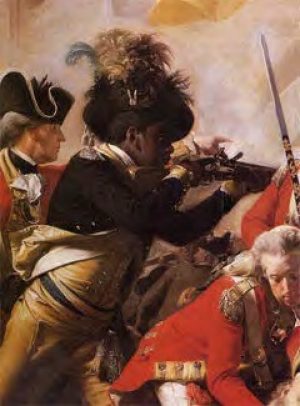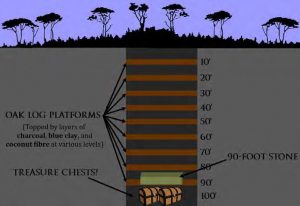The Curse of Oak Island a Family Album
The Curse of Oak Island- Flavor v, Episode 17: A Family Album
The following is a Plot Summary and Assay of Season 5, Episode 17 of the History Channel'due south TV serial The Curse of Oak Island.
.
.
[SPOILER Alert!!!]
.
.
Plot Summary
After an introduction expounding the familial component of the Oak Island treasure hunt, Riley McGinnis and Kel Hancock- descendants of Money Pit co-discoverer "Daniel" McGinnis- recount the legend of the 1795 discovery of the Coin Pit and the story of the Onslow Company.

Side by side, Diana Gregory- a descendant of co-discoverer Anthony Vaughan- with the assist of author Randall Sullivan, relates an former family legend that Vaughan and his partners discovered a "decoy treasure" in the Money Pit, and that Vaughan's father, Anthony Vaughan Sr., used his son's share of this treasure to establish "a huge aircraft empire in New Brunswick". This tale was corroborated by "McGinnis Sisters" Jean, Joan, and Joyce McGinnis in Season 3, Episode 13.
 Subsequently that, our attending is directed towards Samuel Ball, the black slaved-turned-Oak Island landowner who, according Nova Scotian historian Mather Myles DesBrisay'south 1870 book History of the Canton of Lunenburg, was one of the three co-discoverers of the Money Pit (instead of John Smith). Anthony and Ivan Boyd, Brawl's neat great grandsons- along with Charles Barkhouse, Randall Sullivan, and Doug Crowell- describe how Samuel Ball escaped a life of slavery on a South Carolinian plantation by enlisting in the British militia during the American Revolutionary War. They recount how Ball came to Canada afterwards the war, caused land on Oak Island and, perchance with treasure he unearthed while tilling his country, purchased more than property on the island.
Subsequently that, our attending is directed towards Samuel Ball, the black slaved-turned-Oak Island landowner who, according Nova Scotian historian Mather Myles DesBrisay'south 1870 book History of the Canton of Lunenburg, was one of the three co-discoverers of the Money Pit (instead of John Smith). Anthony and Ivan Boyd, Brawl's neat great grandsons- along with Charles Barkhouse, Randall Sullivan, and Doug Crowell- describe how Samuel Ball escaped a life of slavery on a South Carolinian plantation by enlisting in the British militia during the American Revolutionary War. They recount how Ball came to Canada afterwards the war, caused land on Oak Island and, perchance with treasure he unearthed while tilling his country, purchased more than property on the island.
Adjacent, Doug Crowell describes how a Halifax-based newspaper called The British Colonist published a iii-role series on the Oak Isle treasure chase in January 1864. This series, according to Crowell, "gave a full history of the hunt up until that time on Oak Island. Up until that time, it was a very secretive operation."

After that, Crowell, Sullivan, and Neena Chappell (the latter the granddaughter of Oak Island treasure hunter M.R. Chappell) describe the Chappell family unit's involvement in the Oak Island treasure hunt, including William Chappell'due south work as a drill operator nether Oak Isle landowner Frederick Blair, and his son Mel Chappell'southward lifelong interest in the search.
Side by side, we are reminded of Captain Henry L. Bowdoin'southward Oak Isle treasure hunt in 1909. Co-ordinate to the narrator, Bowdoin believed that the Oak Island treasure consists of the 'lost' jewels of 18th Century French Queen Marie Antoinette– a conventionalities shared by 1 of his investors, 27-year-old Franklin D. Roosevelt- future President of the United  States. David Roosevelt, Franklin'southward grandson, and so explains how FDR likely acquired his interest in Oak Isle from his own grandfather, Warren Delano, a wealthy businessman who invested in the Truro Company (an early Oak Isle treasure hunting syndicate) in 1849.
States. David Roosevelt, Franklin'southward grandson, and so explains how FDR likely acquired his interest in Oak Isle from his own grandfather, Warren Delano, a wealthy businessman who invested in the Truro Company (an early Oak Isle treasure hunting syndicate) in 1849.
Later that, Rick Restall, and Lee Lamb -forth with Randall Sullivan, Charles Barkhouse, Doug Crowell- draw the Restall family and their unique treasure hunt in the 1960'southward. They remind u.s.a. of their family's discoveries, including the 1704 rock and the vertical shaft, and of the tragic disaster of August 17, 1965, which took the lives of their father, Robert Restall; their blood brother, Bobby Restall; Karl Graeser; and xvi-twelvemonth-old Cyril Hiltz.
Next, Sharon Olson- the daughter of Oak Isle treasure hunter Robert Dunfield- describes her begetter's oftentimes-maligned heavy duty digging in the Money Pit area in the mid-tardily 1960'due south. "Dad was continually exploring," she explains. "Dad would take Mom and I out on exploring excursions anywhere where Dad thought that there might be something that he could find." Charles Barkhouse so describes how Dunfield'due south massive excavation "obliterated a lot of the landmarks in the Money Pit surface area. Now, had he found the treasure, he'd take been a hero, but that's not the case."
After that, Dan Blankenship and the belatedly Fred Nolan (evidently in interviews filmed years before) independently describe their corresponding treasure hunts on Oak Island, touching on the biting feud that characterized their human relationship with i some other. We are reminded of Dan Blankenship'south discovery of Borehole 10-X and Fred Nolan'southward discovery of Nolan'due south Cross.
Finally, Rick and Marty Lagina describe their lifelong interest in Oak Island, which ultimately culminated in the formation of Oak Isle Tours Inc. and its ongoing treasure chase, around which this History Channel Idiot box series revolves.
Later on nosotros are treated to footage from Flavour iii, Episode 7- in which the team buries a fourth dimension sheathing on the isle to mark the 50th anniversary of author David MacDonald's influential 1965 Reader's Assimilate commodity (Oak Island'due south Mysterious Money Pit)- the diverse Oak Isle "family unit members" of whose interviews this episode is comprised share their terminal statements on the outcome that the island has had on them and their families, and on their relationships with boyfriend treasure hunters. Marty Lagina explains that Oak Island treasure hunters "offset to feel like [they] are part of this series of families. An individual first becomes quite enamored with the isle, and then, because they're part of families, the family unit gets drawn in." Anthony Boyd, in a separate interview, follows up on that idea, maxim, "It's merely not the treasure, but it's the families' lives that have been evolved in this hunt." Diana Gregory adds to that statement, maxim, "Oak Island becomes an obsession for families who are part of the island history." Lee Lamb- who, in fact, wrote the volume Oak Island Obsession on the Restall family unit's Oak Island treasure hunt- adds that the island, in spite of the terrible toll it took on her family, managed to weasel "its way into [her] heart. Oak Island has a very strong pull." Shanon Olson follows up on that statement, saying, "It's almost similar the island calls to you, and even after y'all leave it, you have this longing desire to go back." Finally, the episode concludes with Rick Lagina's statement that the mutual goal shared by all Oak Island treasure hunters "makes it easy to experience like they're a office of us, and we're a part of them."
Analysis
Anthony Vaughan
Anthony Vaughan Jr. was the youngest of the 3 men said to have discovered the Coin Pit in 1795. According to Oak Isle historian D'Arcy O'Connor, Vaughan'southward father, Anthony Vaughan Sr., arrived in the Chester area from Massachusetts in 1772 and began to farm a 200-acre piece of state on the mainland directly beyond from Oak Island, on what is now the town of Western Shore, Nova Scotia. A number of researchers, citing archival material, maintain that Anthony Vaughan Jr. was born in 1782, making him 13 years old at the fourth dimension of the Money Pit's discovery.
It should exist noted that a scattering of Oak Island researchers (including the late Paul Wroclawski, a retired engineer and Oak Island historian who, prior to his expiry on June 15, 2014, presented his spectacularly well-researched Oak Island theories on his website www.OakIslandTheories.com), claim that Vaughan was only 6 or 7 years quondam at the time of the discovery, which they maintain was actually in 1788 or 1789. If true, this piece of information calls the traditional Oak Island discovery legend into question, as it is doubtful that the elder McGinnis would have chosen upon a 6-7 yr-quondam boy to aid with the physically demanding task of hand-digging a xxx-foot-deep pit.
Whatever the case, Anthony Vaughan Jr. lived in Chester, Nova Scotia, until his expiry in 1860. In his later years, his account of the 1795 discovery of the Coin Pit served as a primary source for the manufactures which gave ascent to the famous discovery legend which has been perpetuated by various writers from the mid-19th Century until the present twenty-four hour period.
The McGinnis Sisters
 In the Flavour 3 finale of the History Channel's The Curse of Oak Island (Season 3, Episode thirteen: Secrets and Revelations), the Oak Isle crew was visited past the three sisters- Joan, Jean, and Joyce McGinnis- who claimed to exist straight descendants of Money Pit co-discoverer Daniel McGinnis. The iii sisters presented Oak Isle Tours Inc. with a small-scale, manus-hammered gold cross- a McGinnis family heirloom- and regaled them with an one-time McGinnis family unit fable.
In the Flavour 3 finale of the History Channel's The Curse of Oak Island (Season 3, Episode thirteen: Secrets and Revelations), the Oak Isle crew was visited past the three sisters- Joan, Jean, and Joyce McGinnis- who claimed to exist straight descendants of Money Pit co-discoverer Daniel McGinnis. The iii sisters presented Oak Isle Tours Inc. with a small-scale, manus-hammered gold cross- a McGinnis family heirloom- and regaled them with an one-time McGinnis family unit fable.
According to this McGinnis family legend, Daniel McGinnis, John Smith, and Anthony Vaughan unearthed three treasure chests in the Coin Pit in 1795. Each of these three Coin Pit co-discoverers, upon swearing each other to secrecy, kept a chest for himself and his family. One particular item from the chest Daniel McGinnis claimed- the minor gilt cross- was handed down from male parent to son throughout the generations. Joan, Jean, and Joyce'south late brother Jim was the last male of the McGinnis line to inherit it. Jim McGinnis wore the cantankerous about his neck for most of his life, even taking information technology with him on his tour of duty during the Vietnam War, also as on a series of mysterious New York City business organization trips. During his service overseas, Jim was exposed to Amanuensis Orange, a powerful herbicide employed by the U.Due south. military during the Vietnam War, which resulted in his developing a final illness decades afterward American soil. On January 30, 2006, the nighttime earlier his death, Jim entrusted his sister and caretaker Joan with the artifact, maxim, "… don't always lose sight of the cross. Information technology is the key ." The McGinnis sisters presented this cross- which, according to Oak Island historian Danny Hennigar in a 2007 article, was estimated by appraisers to be over 600 years old- to the Oak Island crew during their recitation of their family's discovery story.
 The McGinnis family version of the story of the discovery of the Money Pit- which is elaborated upon in the 2016 book Oak Isle Connexion: Go Back Over 200 Years to the Mysterious Beginning – is slightly unlike than the popular version in which McGinnis, Smith, and Vaughan are 3 young adventurous farm boys exploring Oak Island on a whim. Like the version of the discovery story put forth by Blockhouse Investigations (www.OakIslandCompendium.com), which is corroborated by Nova Scotia archival records, the Daniel McGinnis of the McGinnis family legend was a 37-year-old Scottish immigrant and veteran of the American Revolutionary War at the time of the discovery of the Money Pit. Co-ordinate to the McGinnis family unit legend, the first person to notice the depression in the soil on Oak Isle's Lot 18 was non Daniel McGinnis, nor John Smith, nor Anthony Vaughan, but rather Daniel's newlywed married woman (or perhaps fiancé) Maria. Maria and Daniel were lying together in a clearing in the woods on Lot 13 looking up at "the sunlight sparkling through the leaves" when Maria noticed the shape of an arrow carved into the bark of a nearby oak tree. The carving was and then faded that it could only be perceived from that position. Afterward investigating the surrounding area more thoroughly, Maria observed that the footing in the clearing was slightly concave, whereupon Daniel began to speculate that the clearing might be the site of a buried treasure. With the aid of his friend John Smith and the immature island resident Anthony Vaughan, McGinnis excavated the depression to a depth of 30 feet, finding a layer of flagstones just below the surface and platforms of oak logs at regular ten-human foot intervals. Sometime before reaching the thirty-foot level, the three men unearthed iii modest treasure chests, which they divided amongst themselves. Convinced that these chests comprised a decoy treasure, and that the truthful treasure lay far below, the three men remained more or less involved with the Oak Island treasure hunt until their deaths.
The McGinnis family version of the story of the discovery of the Money Pit- which is elaborated upon in the 2016 book Oak Isle Connexion: Go Back Over 200 Years to the Mysterious Beginning – is slightly unlike than the popular version in which McGinnis, Smith, and Vaughan are 3 young adventurous farm boys exploring Oak Island on a whim. Like the version of the discovery story put forth by Blockhouse Investigations (www.OakIslandCompendium.com), which is corroborated by Nova Scotia archival records, the Daniel McGinnis of the McGinnis family legend was a 37-year-old Scottish immigrant and veteran of the American Revolutionary War at the time of the discovery of the Money Pit. Co-ordinate to the McGinnis family unit legend, the first person to notice the depression in the soil on Oak Isle's Lot 18 was non Daniel McGinnis, nor John Smith, nor Anthony Vaughan, but rather Daniel's newlywed married woman (or perhaps fiancé) Maria. Maria and Daniel were lying together in a clearing in the woods on Lot 13 looking up at "the sunlight sparkling through the leaves" when Maria noticed the shape of an arrow carved into the bark of a nearby oak tree. The carving was and then faded that it could only be perceived from that position. Afterward investigating the surrounding area more thoroughly, Maria observed that the footing in the clearing was slightly concave, whereupon Daniel began to speculate that the clearing might be the site of a buried treasure. With the aid of his friend John Smith and the immature island resident Anthony Vaughan, McGinnis excavated the depression to a depth of 30 feet, finding a layer of flagstones just below the surface and platforms of oak logs at regular ten-human foot intervals. Sometime before reaching the thirty-foot level, the three men unearthed iii modest treasure chests, which they divided amongst themselves. Convinced that these chests comprised a decoy treasure, and that the truthful treasure lay far below, the three men remained more or less involved with the Oak Island treasure hunt until their deaths.
The author of this article must mention that, upon publishing an account of the the McGinnis Sisters' visit to Oak Isle in his 2016 book Oak Isle, he was contacted past a well-respected Oak Island historian who presented him with show strongly indicating that the sometime family legend told past the McGinnis Sisters- specifically the office about the three decoy treasure chests- was more of a fictional tale than a historical account. In spite of this, Oak Island historian Doug Crowell, in a 2016 article, revealed several pieces of information which seem to lend credence to the merits. One such slice of information was given to them by Diana Young Gregory, a descendant of Anthony Vaughan who appears in this episode. While researching Oak Island, Gregory came across a newspaper commodity from September 9, 1991, written by a Nova Scotian journalist named Carl Mosher. The article states that a descendant of Anthony Vaughan was shown 25 canvas numberless filled with gold by his grandmother Lucy in 1925. The human being's grandmother maintained that the treasure came from Oak Island. Unfortunately, the gold was later stolen past the man's uncle, Edward Vaughan, who vanished shortly thereafter, leaving behind "his property, business, wife, and family." Another piece of prove the Blockhouse squad brought to lite was the fact that Oak Isle treasure hunter Fred Nolan, in the early 1980'due south, claimed to accept discovered three aboriginal, empty oak chests buried in the Oak Island swamp. Three terminal pieces of evidence which seem to support the notion that decoy treasure chests were unearthed on Oak Isle are the mysterious primal introduced in Season 5, Episode 12, which Fred Nolan found on Oak Island; the keyhole covering discovered on Oak Island Lot 8 in Season 5, Episode 15; and the ruby brooch discovered the previous episode, likewise on Lot 8.
In Kerrin Margiano'due south (Jean McGinnis' girl) 2016 book Oak Island Connection: Go Back Over 200 Years to the Mysterious Beginning, Joan, Jean, and Joyce McGinnis (it should be noted that Joyce McGinnis passed abroad on Valentine'south Day, 2016, simply two and a half months earlier the book's publication) elaborate on the McGinnis family stories regarding Oak Island. After reading reputable books on the history of the Oak Island treasure hunt, like D'Arcy O'Connor'southward The Clandestine Treasure of Oak Island, or R.V. Harris' The Oak Island Mystery, one gets the impression that the McGinnis, Smith, and Vaughan families' interest in the Oak Island treasure chase died with their Money Pit-discovering progenitors. On the contrary, the McGinnis sisters, in the book put together by Margiano, paint a fascinating picture show of a family characterized by a two-century-long legacy of treasure hunting, suggesting that the McGinnis family never gave upwardly on the Oak Isle mystery. The McGinnis sisters recount how, in their babyhood, their father and uncles would sometimes "sit down effectually the kitchen tabular array strategizing, cartoon plans and studying maps" in an attempt to solve the Oak Island riddle that had held their family unit in thrall for over ii centuries. Joan, Jean, and Joyce recount some of the stories passed downwardly to them by their grandpa George William "Neb" McGinnis, an Oak Isle resident, and their uncles Wally, Roy, Albert, Roy, and George McGinnis. These stories include, amidst others:
- An culling Money Pit discovery story, as described above.
- Daniel's saving a desperately-burned privateer who had been aboard the Young Teazer (a United states of america privateer schooner which, while existence hounded in Mahone Bay past British Royal Navy warships during the War of 1812, was blown upwards by one of its coiffure members in the summertime of 1813) a the time of its destruction.
- Daniel's witnessing the showtime so-called "Teazer Low-cal" (the ghost of the Immature Teazer, manifest equally a silent burning ghost ship, said to appear in Mahone Bay at the site of the explosion near the ceremony of the ship's destruction) in the summertime of 1814.
- The tale of the ghost of a red-coated British soldier said to haunt Oak Isle.
- The story of a expletive put on the men of the McGinnis family by a Mi'kmaq shaman.
- A secret clandestine hatch located a few inches below the surface in the vicinity of the ruins of the historic McGinnis family unit motel.
The McGinnis sisters also tell of other family heirlooms and clues relevant to the Oak Island treasure hunt, including a gold asset endemic by their uncle Wally said to have come from Oak Isle, and a copy of the mysterious document which has come up to be known as La Formule.
Want to Help?
If you enjoyed this article and would like to help back up this website, delight check out our online bookshop:

LEGENDS OF THE NAHANNI VALLEY

THE OAK Island ENCYCLOPEDIA

MYSTERIES OF CANADA: Volume I

Mysteries of Canada: Volume 2

INDIAN TALES OF THE CANADIAN PRAIRIES

Archetype French-Canadian Folktales: Volume I

2 Journals of Robert Campbell
Source: https://mysteriesofcanada.com/nova-scotia/the-curse-of-oak-island-season-5-episode-17-a-family-album/
0 Response to "The Curse of Oak Island a Family Album"
Post a Comment